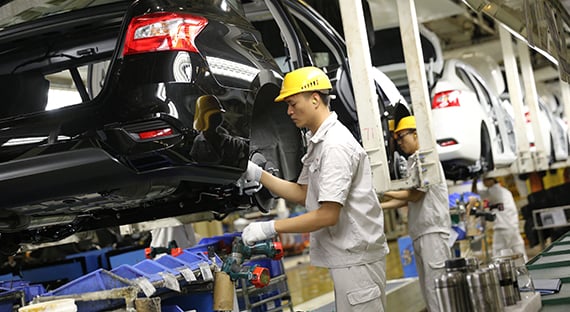
Workers assemble cars at an auto plant in Guangdong Province, China: accelerating reforms will be critical in helping China sustain strong growth (photo: Imagine China/Newscom)
China's Economic Outlook in Six Charts
August 15, 2017
China continues to enjoy strong growth—projected at 6.7 percent for 2017. And the country has potential to sustain strong growth over the medium term. But to do so safely requires speeding up reforms to make growth less reliant on debt and investment, the IMF said in its latest annual assessment of the economy.
Here are the six things you need to know about this report.- IMF staff have revised up China’s growth outlook compared to last year’s report. Growth between 2017 and 2021 for the world’s second largest economy is now expected to average 6.4 percent, compared to 6.0 percent last year.
- But at a cost of higher debt, which leads to rising risks. According to the
IMF’s report, total non-financial sector debt—which includes household,
corporate and government debt—is expected to continue to rise strongly,
reaching almost 300 percent of GDP by 2022, up from 242 percent in 2016.
This raises concerns for a possible sharp decline in growth in the medium
term.

- Given strong growth momentum, now is the time to intensify deleveraging
efforts. The Chinese government has started to take important initial steps
to facilitate private sector deleveraging—credit growth is slowing and the
large “credit gap” is narrowing. These efforts should intensify, with the
overarching priority being to focus more on the quality and sustainability
of growth, and less on quantitative targets.

- To grow strongly, but also sustainably, China needs to boost consumption. At 46 percent of GDP, China’s national savings are 26 percentage points higher than the global average, largely due to the household sector, with consumption correspondingly low. This reduces the current welfare of Chinese citizens, fosters high levels of investment which are unlikely to be absorbed efficiently, and, were investment to fall, would lead to even larger current account surpluses, worsening global imbalances.
- Social spending in China is on the rise, but more can be done. Increasing government spending on health and pensions would increase government consumption, but also private consumption by reducing households’ need to save. Increasing the progressivity of the tax system could finance higher social spending and reduce income inequality, which is among the highest in the world.
- China also needs to increase productivity. This can be done by making better use of resources that are currently going to loss-making (“zombie”) companies, overcapacity industries, and State-Owned Enterprises (SOEs). The IMF estimates that such efforts could increase the contribution of productivity to growth by about 1 percentage point over the long term.






